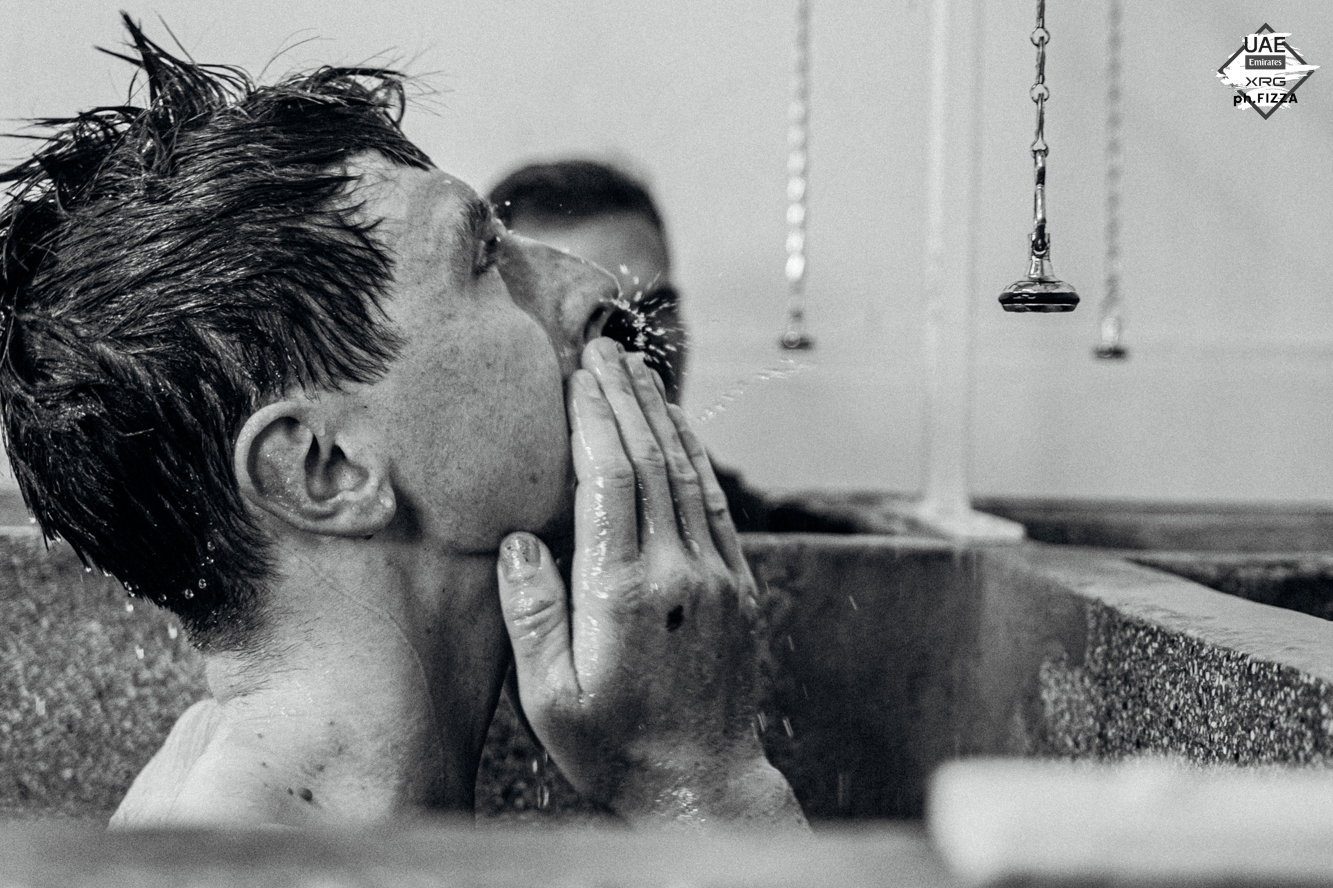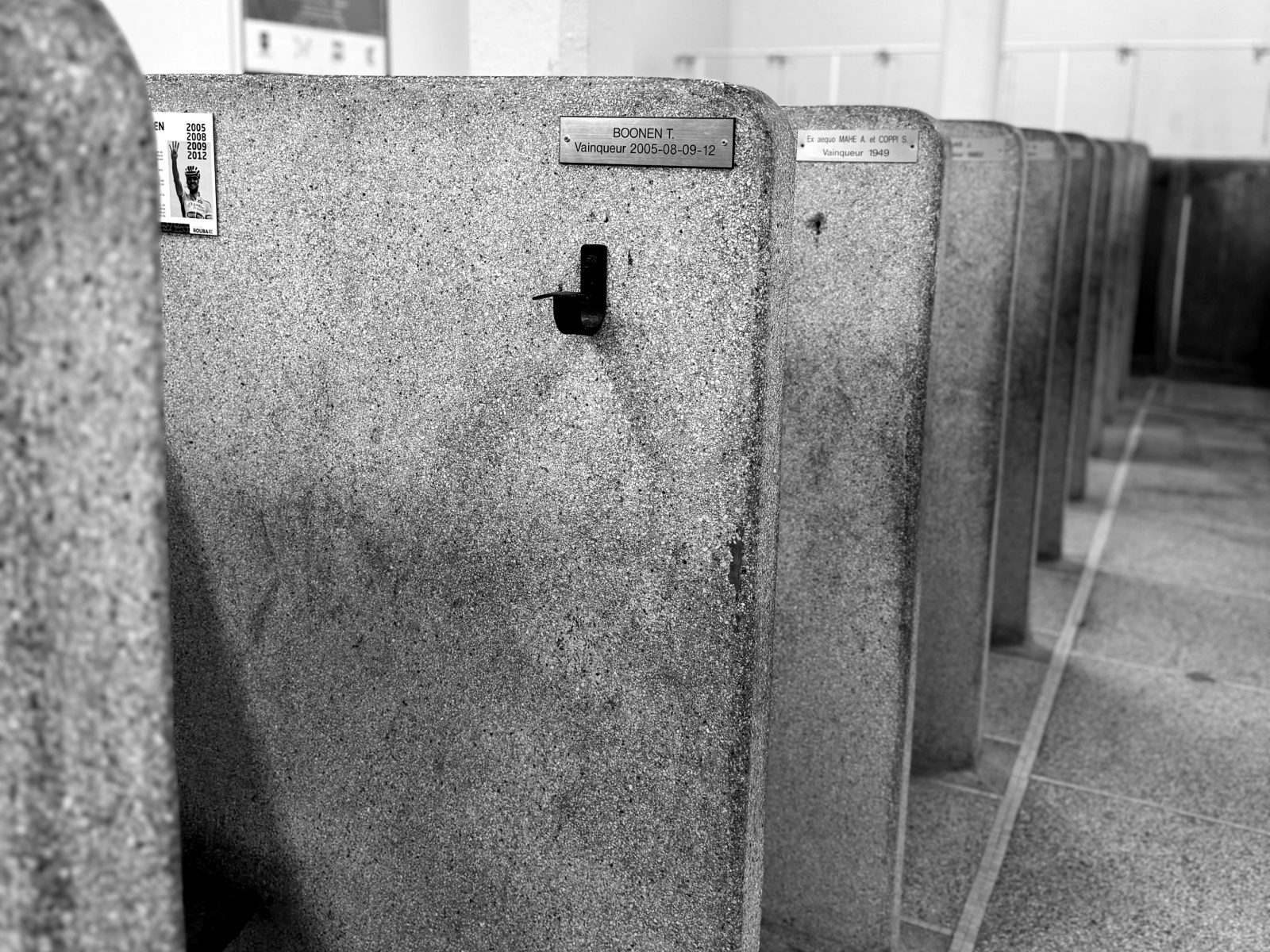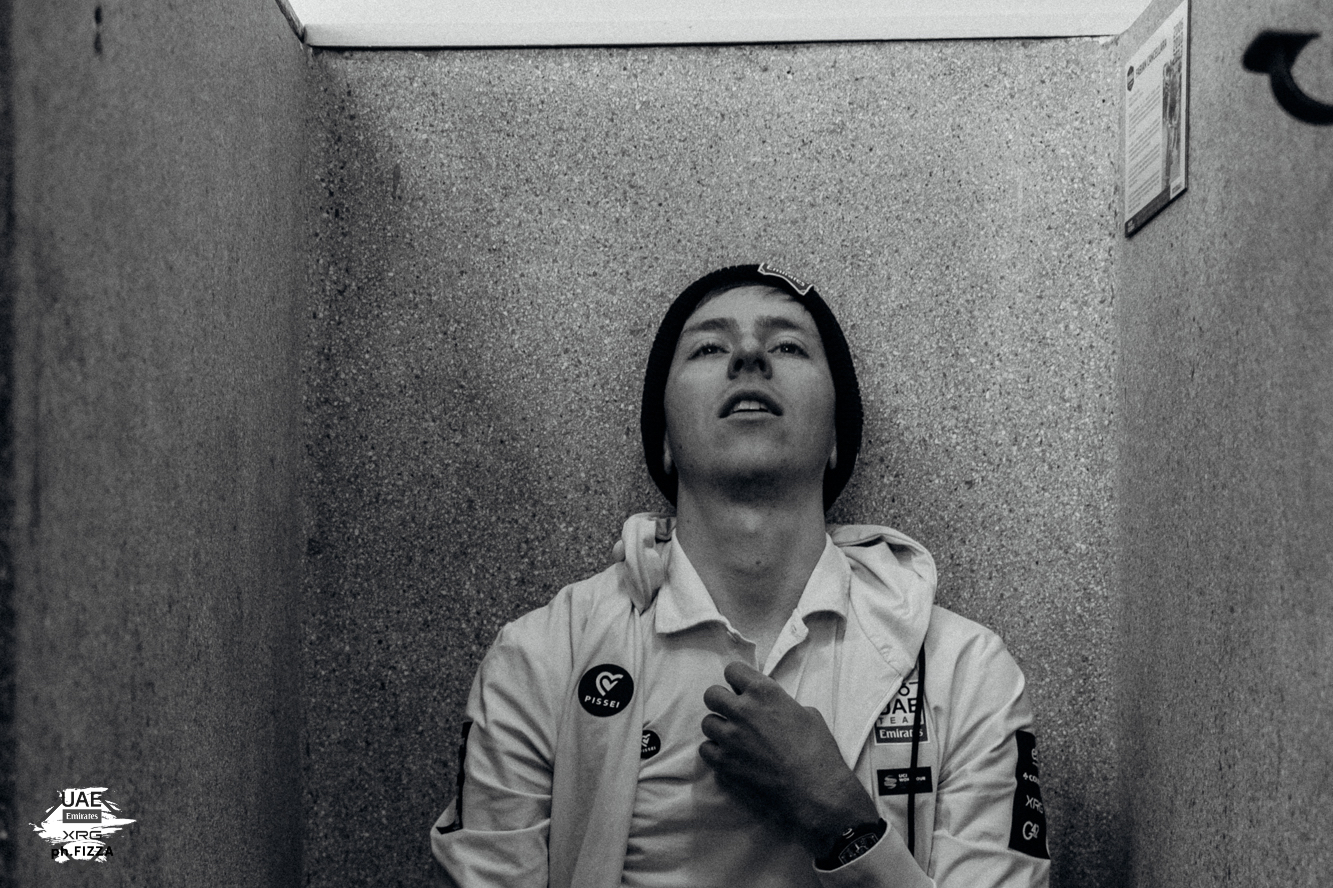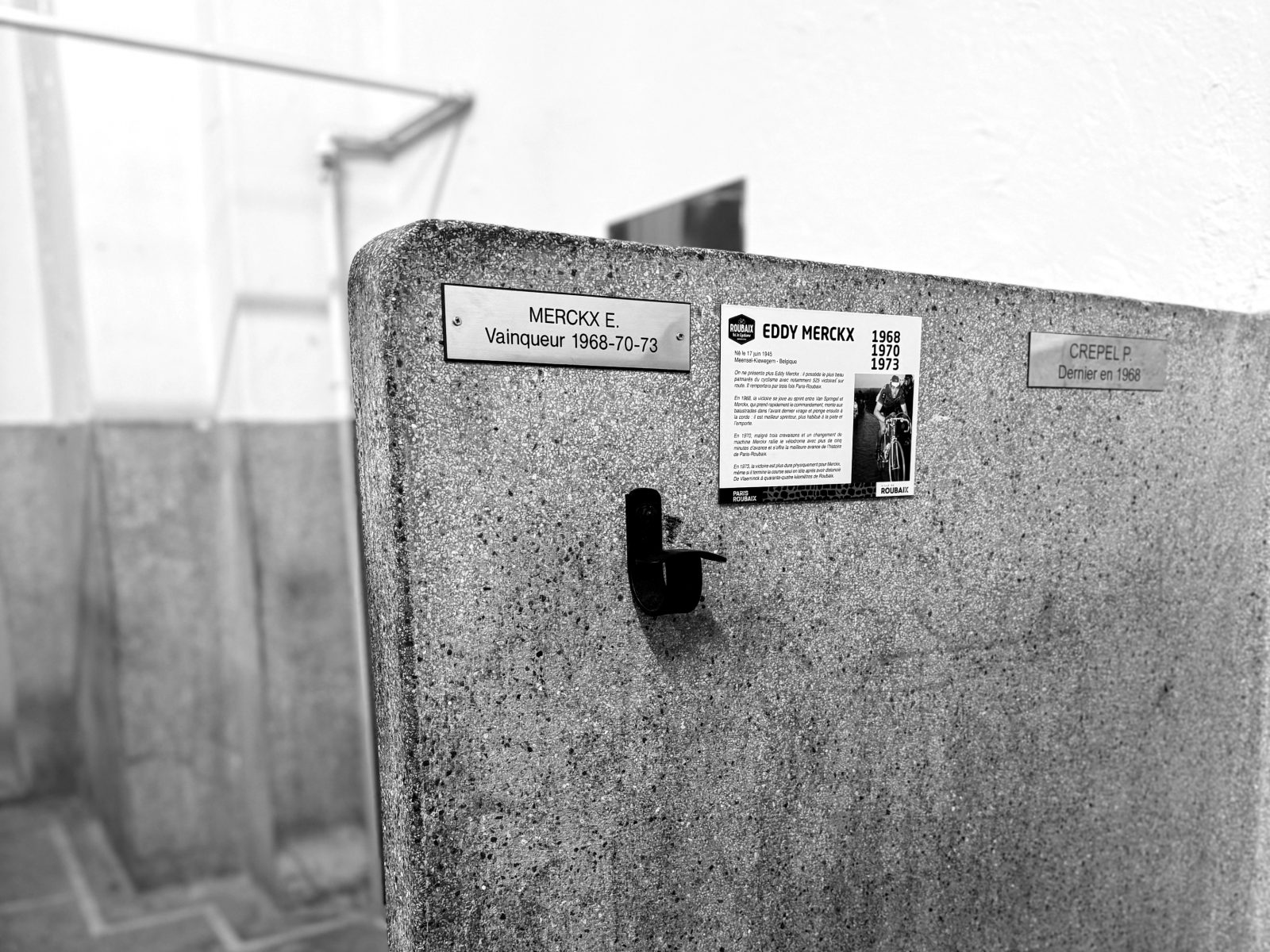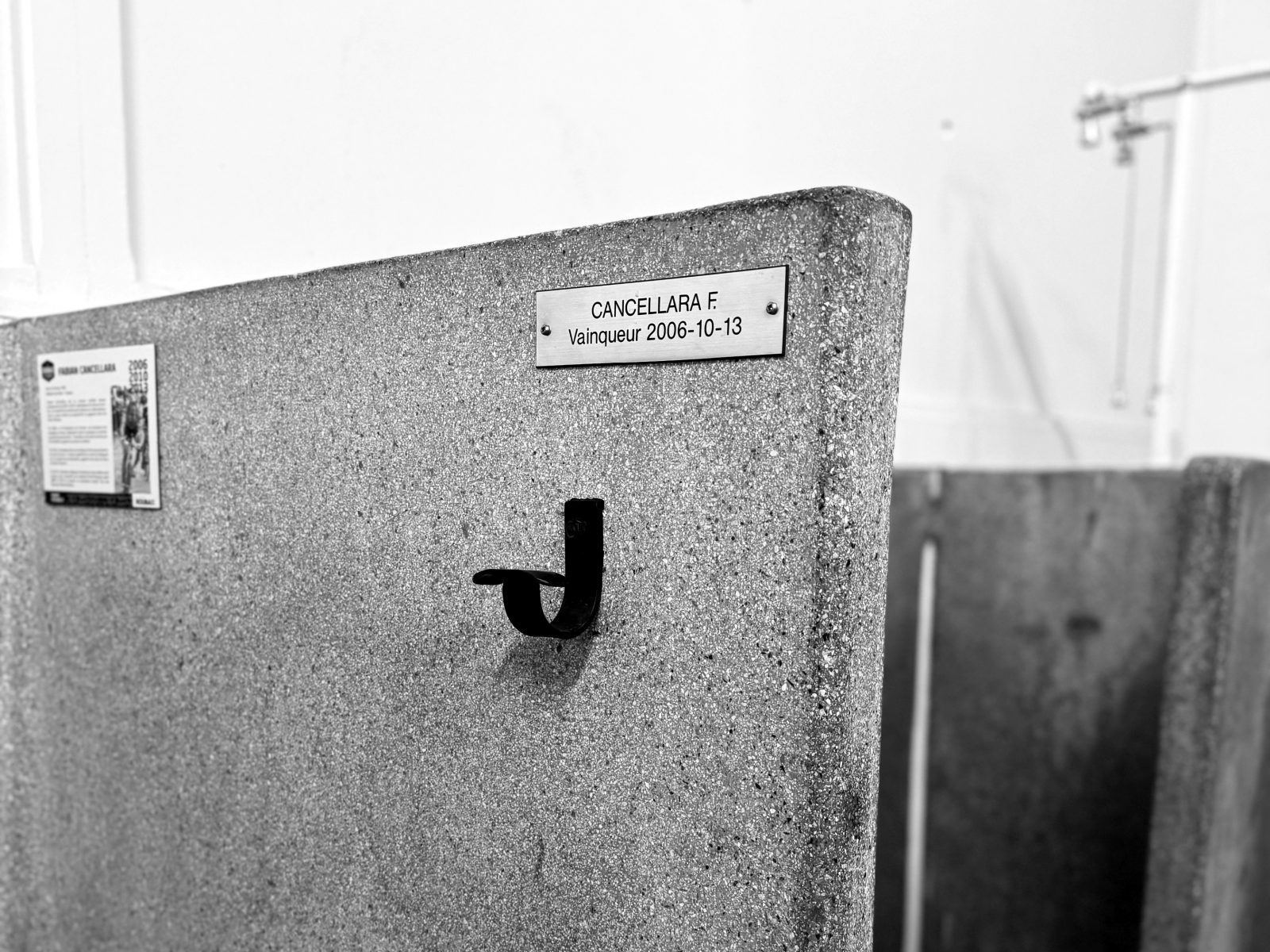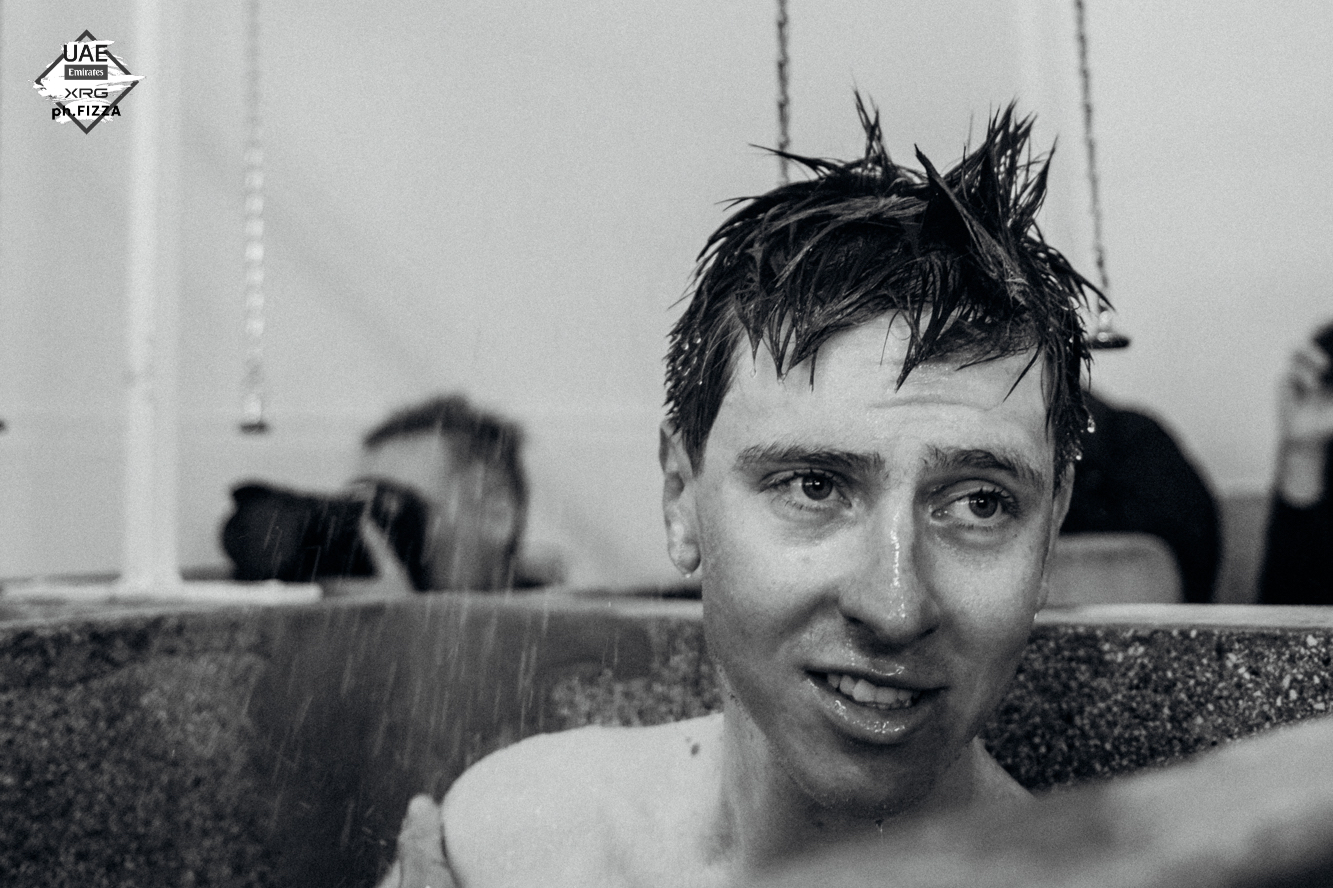Gallery | Paris-Roubaix | Team • April 18, 2025
The timeless inner sanctum: Pogačar steps into the Paris-Roubaix showers
Our account from behind the curtain of cycling’s toughest one-day race, as UAE Team Emirates-XRG’s Tadej Pogačar pays homage to the past
There are some moments whose significance will last a lifetime. On any other day, it might have been the thunderous cacophony of noise that bellowed out from the Trouée d’Arenberg or the surreal sight of watching the reigning Tour de France champion take to the start of Paris-Roubaix, but in the quiet anticipation of the Roubaix Velodrome shower block, it was the echoing chants of those gathered outside that were enough to take the breath away.
“Tadej! Tadej! Tadej,” roared the hundreds of supporters gathered outside this nondescript building, whilst inside, a gaggle of photographers primed their lenses, gathered their breath and prepared for one of the most important appointments of the year.
The history and symbolism that are housed between these walls are enough to fill an anthology, but today we will settle for this account alone.
For all the acclaim of a rainbow jersey-clad Tadej Pogačar finishing on the podium at Paris-Roubaix – becoming the first reigning Tour champion to do so since Eddy Merckx in 1975 – it is the image of the grey, eerie and traditional showers that is just as intrinsic to the rich history of this great race.
Between the decades-old Vélodrome André-Pétrieux — the iconic home of the Paris-Roubaix bike race — and the modern, state-of-the-art Stab Vélodrome de Roubaix that was built just a few hundred metres away in 2012, lies a red and white municipal building that in any other context would be overlooked by the passer-by. But on the second Sunday of every April, this unremarkable outpost becomes the very centre of the cycling world.
With the podium ceremony complete for the second-placed Pogačar, all it took was a small detour from the press conference to enter the courtyard of Roubaix’s shower block. With a wave towards those who bellow his name, there the UAE Team Emirates-XRG man was, ushered inside an ageing complex that in any other sport would have been long forgotten, but in cycling, evokes the same feelings as when the winner of the Masters first steps inside Butler Cabin at Augusta Golf Course.
There he was, within the bowels of the toughest bike race in the world, and soon to enjoy a moment of pilgrimage that passes from one generation to the next. As the world champion readied to follow in the footsteps of the greats, suffice it to say, the Paris-Roubaix shower block has stood the test of time.
A journey back in time
To step inside the shower block is to place yourself in a bygone age. Sure, there are the occasional markers of the modern day — the fluorescent light strips on the ceiling, glass-framed posters from recent races hanging on the wall and the avant-garde cameras yielded by those in attendance — but for the most part, this place has remained visually unchanged since its origin in 1936.
Lining the two rooms, which are separated by a singular door, are rows of sandstone changing cubicles which are three-walled, contain a wooden bench some two feet off the ground and quite noticeably, are marked by the engraved brass plaques which contain the names of past winners.
From MUSEEUW J. and KELLY S. to BOONEN T. and HINAULT B., these plaques are held in place by two small screws and within each cubicle, a small sign is affixed that details the hows, whys and wherefores of each victor’s success. Each winner since the first man to use these showers in 1943 is invited to be at the unveiling of their commemorative plaque.
86 years ago, it was the Belgian Marcel Kint who first used the showers inside Roubaix’s Parc des Sports, having won the first edition of Paris-Roubaix since the outbreak of war in 1939. The facilities, shared by the Roubaix boys’ school, were a luxury for the time, as noted by Philippe Bouvet in his book Paris-Roubaix: A Journey Through Hell.
‘Gone were the water basins and the precarious toilets. Now they had the luxury of true showers. Washed and dried, Kint returned to his home in Belgium by bicycle.’
These days, the showers are no longer contemporary and nor is there a desire for them to be so. In fact, when the showers were partially rebuilt a little over a decade ago, the town of Roubaix had to work hard to track down sandstone and equipment similar to that used when the stone was first quarried in 1935. Nonetheless, riders who remain in touch with the tradition of the sport still make their pilgrimage to the building each year and resist the temptation of washing in the relative luxury of their team buses.
Owing to the low-walled changing cubicles, the first thing to notice as the building’s door swings open are the faces of those soaking away the day’s woes and pondering over what just happened.
These low-rise walls were designed for conversation. It was over these parapets that Jean Stablinski was derided by his fellow riders in 1968 for having suggested the introduction of the Trouée d’Arenberg to the race organisers, and it was here on Saturday that the world’s best women’s riders will have swapped battle stories in adjoining cubicles after the fifth-annual Paris-Roubaix Femmes.
It is hard to get away from the rich history of this shower block, not that you would want to. Look closely at the cubicle devoted to three-time winner Merckx (1968, 1970 and 1973), you will soon spot a plaque denoting CREPEL P., Dernier en 1968. That’s right, the Belgian great shares his cubicle with Philippe Crépel, the last-place finisher in 1968.
Crépel, a member of the Roubaix bicycle club, finished 43rd (last on the day) and was jokingly honoured with his own plaque. “He shed a tear. So we didn’t dare remove the plaque, once we saw what it meant to him,” recounted the secretary of the club to author Bouvet.
As detailed by Bouvet, Crépel would later refer to himself as a ‘representative of all those who have finished Paris-Roubaix.’
It is only apt that Crépel’s name remains, symbolising all those riders who were able to finish Paris-Roubaix, despite the hardships suffered out on the cobbles. These showers are a meeting place for the champions and the finishers alike, a place where the heroes and the survivors come together to wash away dirt, sweat and (often) blood all the same.
Here, even the rainbow stripes of the world champion give way to the bare skin of the mortal man beneath.
With a yank of the chain, Pogačar makes his pilgrimage
“Tadej! Tadej! Tadej!” chant the crowd as the day’s runner-up makes his way inside. Wide open swung the door and in bellowed the ferocious cheers of those outside. There, they would have to wait, however, as their world champion strode into the showers alone, his every footstep from his New Balance trainers echoing against the drab walls.
The Slovenian was draped in his Pissei-supplied rainbow jersey, of course, and would soon hang his stripes from a hook on the wall, still sporting the mud and grime of northern France.
Already attracting the attention of fellow riders, Pogačar walks into the left-hand room and heads immediately for the cubicle belonging to three-time champion Fabian Cancellara (2006, 2010, 2013).
In getting the better of Pogačar on Sunday afternoon, Mathieu van der Poel (Alpecin-Deceuninck) has joined the Swiss on three wins in this Classic. Just one week earlier at the Tour of Flanders, it was Pogačar who had enjoyed his own date with history, moving past Cancellara in the all-time list to sit on eight Monument victories.
As the photographers look on with a respectful silence, Pogačar strides to the back of the room and stands beneath the showerhead. There, he disrobes from his rainbow skinsuit and grabs a bar of soap. With a yank of the metal chain, water begins to flow and he takes a second to let the moment sink in. The world champion soon notes that although the water runs warm, the presence of those riders before him has left the water pressure with a lot to answer for, much to the amusement of all in attendance.
For the next few minutes, Pogačar attempts to wipe the day’s dirt from his body, face and hair, stopping every so often to give another yank of the chain, as though he were featuring in one of those 20th-century black and white classic films. It is an image that would appear alien in any other sport, but for all lucky enough to be standing in the Roubaix showers, another chapter is added to the rich tapestry of Paris-Roubaix.
Final snapshots taken, the press are kindly invited to take their leave and time is called on this year’s Paris-Roubaix. We begin to brainstorm an exit plan to the nearby team bus, as Pogačar is allowed a moment to himself.
Stripped of his rainbows, the Slovenian is just another man. He sweats, his crevices are still full of grime, and he’d rather have a moment of privacy than a dozen cameras in his face — understandable — but in reality, the 26-year-old is already a giant among men.
Left alone in the room full of champions, Pogačar has joined an elite group of riders to have won the Tour de France and tackled the cobbles of Paris-Roubaix the year after. It is something that many thought the sport would never see again.
Over the next couple of years, he may look to join the three riders with nine Monument victories to their name and somewhere down the line, perhaps he will trouble Roger De Vlaeminck with 11 in his palmarès. For the time being, though, he will take a moment to gather himself before venturing outside and back into the arms of his devoted supporters.
With that, the showers are left empty and the curtain falls on this year’s Queen of the Classics. For the next 12 months, this nondescript building will return to anonymity, save for the odd guided tour, but there it will remain, echoing with the stories of days gone by and waiting for the next tales to be written on the cobblestones of l’Enfer du Nord. This is the place that Paris-Roubaix will always call home.

